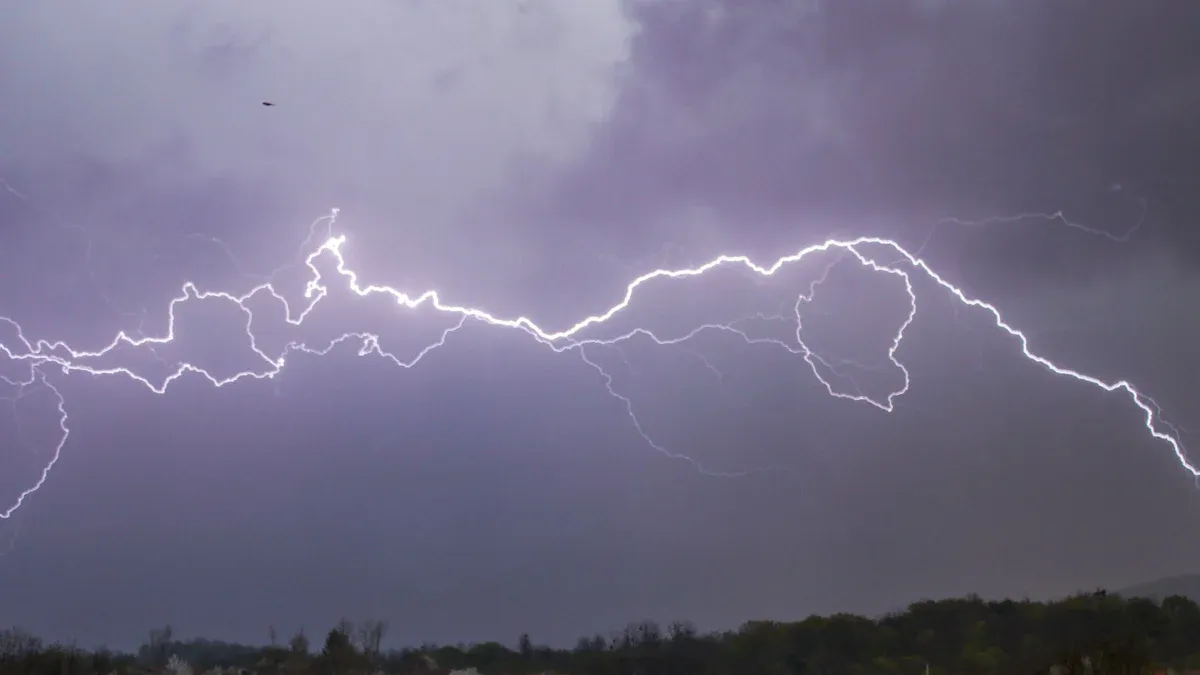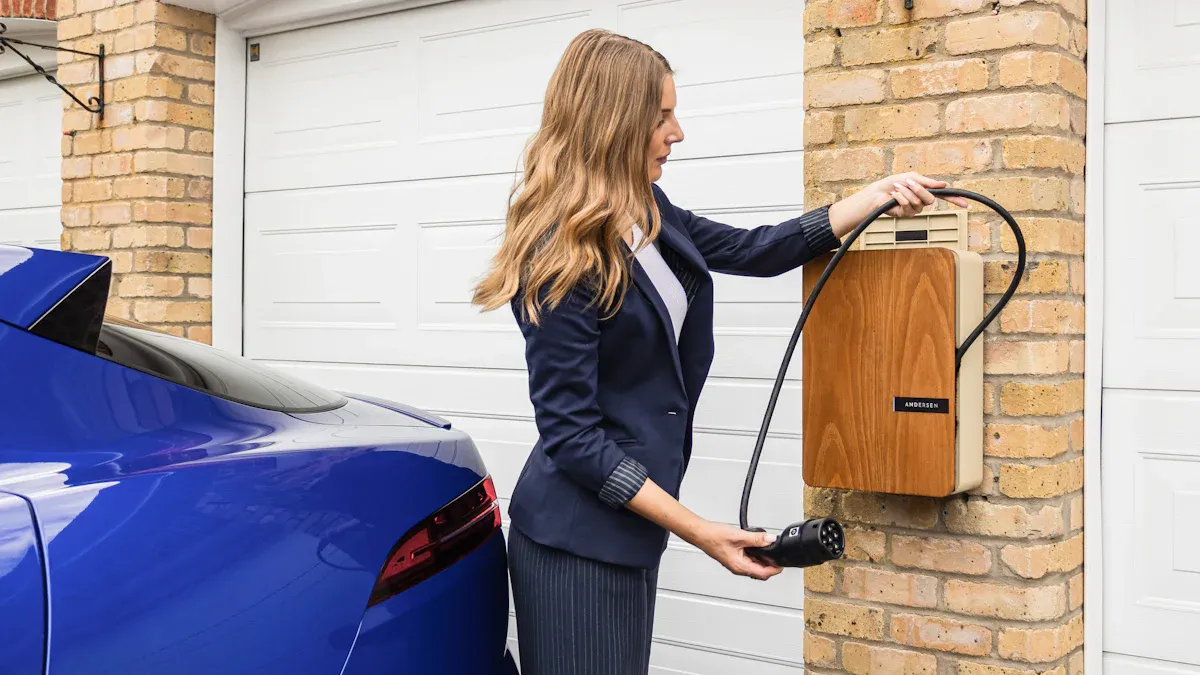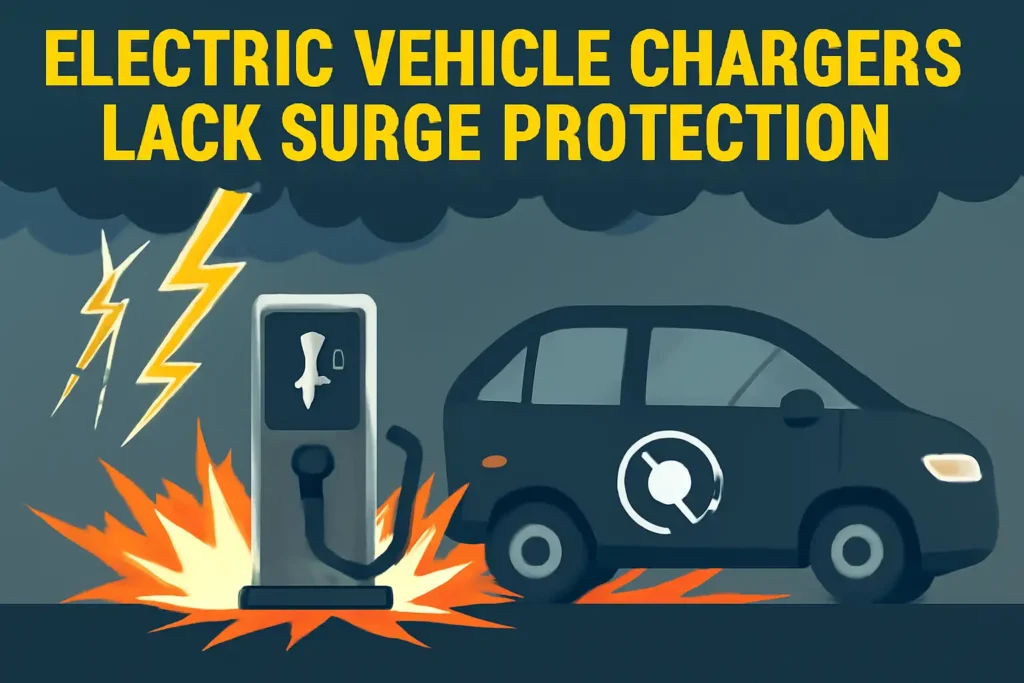If your electric vehicle charger does not have surge protection, you are at risk. Power surges can break your equipment and cause safety problems. You may have to pay a lot for repairs or lose your warranty. New rules often say you must have surge protection for chargers inside and outside. Surge protection helps keep your charger, your car, and your home safe.
Key Takeaways
- Power surges can hurt your electric vehicle charger. They can also harm your car battery and your home. This can lead to expensive repairs. It can also cause safety problems.
- Surge protection devices stop extra electricity from storms. They also help during grid problems. These devices keep your charger and car safe.
- Many new rules say you must have surge protection. Warranties may not cover you without it. You could also have legal trouble if you do not use it.
- A licensed electrician should install surge protection. This lowers the risk of fire. It also helps you save money on repairs.
- Look at your charger and electrical panel for surge protection signs. Add or upgrade protection if you need to.
Risks

Power Surges
Power surges happen when too much electricity flows in your home. This can happen after lightning, a blackout, or problems with the electric grid. Old homes with bad wiring or too many things plugged in can also cause surges. These surges send extra electricity to your electric vehicle charger.
- Lightning near power lines or transformers can send a lot of electricity into your house.
- Problems with the grid during storms or broken equipment can cause smaller surges that still hurt your stuff.
- Even turning on big appliances at home can make short bursts of high voltage.
⚡️ Power surges can make circuit breakers flip, blow fuses, and stop charging. You might see your charger turn off or your lights blink during storms.
Outdoor chargers are in more danger because they connect right to outside power lines. Surges from lightning or the grid can reach these chargers fast. If you do not have surge protection, your charger is not safe from these spikes.
Electric Vehicle Charger Damage
A power surge can break the small parts inside your electric vehicle charger. The charger uses circuits to control how much power goes to your car. If the voltage jumps, these circuits can burn out very quickly.
- Lightning can ruin the charger and even start fires.
- Small surges over time can slowly damage the charger’s parts.
- High voltage can break the insulation inside the charger, making it stop working forever.
If your charger breaks, you might have to wait for repairs and pay a lot. Some people have had their chargers stop working after storms. You could also lose the ability to charge your car at home.
Vehicle Battery Impact
A power surge can go through the charger and reach your car’s battery and electronics. The battery costs a lot to replace. If a surge hits it, the battery might not last as long. Your car may not drive as far, or the battery could fail early.
- Surges can hurt the computer systems in your car.
- Charging with too much power can make the battery unstable.
- Some fires at charging stations have made people worry about safety, but surges are not always the cause.
🚗 About one out of three electric vehicle fires happen while charging, says insurance data. Not all are from surges, but this shows why surge protection is important.
Outdoor charging stations are at even more risk. They are outside in bad weather and can get hit by surges from lightning or the grid. Surge protection helps keep your charger and your car’s battery safe.
Safety & Costs
Fire Hazards
If your charger does not have surge protection, it is not safe. Power surges can make too much electricity flow. This can cause short circuits or even electric shock. These problems can break your charger or start a fire. Lightning and grid surges can push extra electricity into your system. If your charger cannot watch the current or stop it fast, wires can get too hot and melt. This can cause a fire.
- Too much voltage or short circuits can hurt your charger and wires.
- Broken safety tools, like ground fault circuit interrupters (GFCI), make fires more likely.
- Lightning and grid surges can start fires, especially outside.
- Bad wiring, sparks, or old equipment can also cause fires.
- Poor installation or using the wrong charger can make electrical problems.
In 2021, a charger failed because it did not have good short-circuit protection. The cable got too hot and started a car fire. You can lower these dangers if a licensed electrician puts in your charger and follows safety rules.
Repair Expenses
If a surge breaks your charger, fixing it can cost a lot. The U.S. Department of Energy says you should save up to $400 each year for repairs after your warranty ends. Fixing surge damage usually costs between $100 and $1,000. If you need a new charger, the price depends on the type:
| Cost Aspect | Cost Range (USD) |
|---|---|
| Repair Cost | $100 – $1,000 |
| Level 1 Charger Price | $300 – $600 |
| Level 2 Charger Price | $500 – $700 |
| Level 3 Charger Price | $12,000 – $45,000 |
Surge protection helps you avoid these big costs. It keeps repair bills lower and saves you money on maintenance.
Insurance Issues
Insurance for charger damage from surges is not always simple. Some insurance covers surge or outage damage, but some does not. What is covered depends on your insurance company and your policy. Some plans pay for lost business if you run a public charger. Others do not pay for transformer or surge damage. You should read your policy and make sure it protects you from surge risks.
📝 Tip: Always check your insurance policy and ask your provider if surge damage is covered.
Regulations
Warranty Problems
If you do not use surge protection, you could lose your warranty. Many companies say you must use surge protection to keep your warranty. If a power surge breaks your charger and you did not use a surge protector, the company might not fix it or give you a new one. Always read your warranty papers. Look for rules about surge protection. This helps you avoid surprise costs if something goes wrong.
Legal Requirements
New rules now say you need surge protection for many homes and chargers. In the United States, the National Electrical Code (NEC) has changed:
- The 2020 NEC added Article 230.67. This rule says you must use a surge protective device (SPD) for all new homes and when you change the main service equipment.
- The SPD must be Type 1 or Type 2. You have to put it at or near the main service panel.
- The 2023 NEC made these rules cover dorms, hotels, and nursing homes too.
Other countries have their own rules. For example, the UK Wiring Regulations now say you need surge protection for all new circuits, including electric vehicle charger setups. Some places let you skip the SPD, but most experts say you should use one.
Here is a table that shows rules in different places:
| Region/Country | Surge Protection Mandate for Residential EV Charging Installations | Relevant Code/Standard |
|---|---|---|
| United States | Mandatory for all new residential main panels, including EV chargers | NEC 230.67 |
| European Union | Recommended or mandatory for commercial/industrial; not always for homes | IEC 61851 |
| United Kingdom | Mainly for commercial/industrial; less clear for homes | IEC 61851 |
| Australia | Mostly for commercial/industrial | N/A |
| India | Mainly for critical infrastructure | N/A |
| Japan | Mainly for critical infrastructure | N/A |
Manufacturer Advice
Most charger makers say surge protection is very important. They tell you to use AC power line surge protectors made for electric vehicle chargers. These devices help stop damage from lightning, power failures, or mistakes during charging. Some companies give long warranties, but only if you use the right surge protector. They also say a licensed electrician should put in the surge protector. This keeps your charger and your home safe. Many surge protectors also help protect other electronics in your house.
🛡️ Tip: Always follow what your charger’s maker says. This keeps you safe and keeps your warranty good.
Protection Steps

Check for Surge Protection
Start by seeing if your electric vehicle charger has surge protection. Look for lights or labels on your charger or the electrical panel. Many surge protection devices have a green or red light. Green means it works. Red means you need a new one. You might see labels that show the device is safe or tested by groups like UL or IEC. Some surge protection devices say if they are Type 1, 2, or 3. They also show if they fit your home’s voltage and wiring.
| Key Indicator / Label | Description |
|---|---|
| Visual Status Indicators | Green = working; Red = replace |
| Compliance Labels | Shows device meets IEC/EN standards |
| SPD Type Identification | Type 1, 2, or 3 listed on device |
| Voltage Suitability | Works with AC or DC for EV charging |
| Certification and Testing | UL, IEC, or other lab marks for safety |
🕵️♂️ Tip: If you do not see these signs, your charger might not have surge protection.
Add or Upgrade Protection
If you do not have surge protection, you can add it. Most homes use a whole-house surge protector. This device goes near your main electrical panel. It protects all outlets, including the one for your electric vehicle charger. Pick a surge protector with a high joule rating and fast response time. Make sure it has a UL safety label. For outdoor chargers, choose a weatherproof model. Some surge protectors plug in between the charger and outlet. Others are hardwired and stay in place.
| Surge Protector Model | Joule Rating | Clamping Voltage | UL Listed |
|---|---|---|---|
| Siemens FS140 Whole House Surge Protector | 140,000 | 400V | Yes |
| Eaton CHSPT2ULTRA Ultimate Surge Protector | 2,880 | 600V | Yes |
| ONESTOP panel installation surge protector | 3,400 | 400V | Yes |
💡 Note: Whole-house surge protectors help keep your electric vehicle charger and other electronics safe from big surges.
Professional Help
Ask a licensed electrician to check your setup. Electricians know how to find problems and put in surge protection safely. They help you pick the right device for your home and charger. They also make sure your system follows local codes and manufacturer rules. This step keeps your home and car safe from electrical problems.
If you do not use surge protection, you can have big problems.
- Your charger and car electronics can get damaged.
- You might pay more for repairs or deal with fire danger.
- Safety problems could hurt people or damage your things.
- Insurance or warranty claims might not work for you.
Surge protection helps keep your charging system safe and working right. You should look at your setup and ask a skilled electrician for help if needed. Doing this now keeps your stuff safe and helps you worry less.
Choose ONESTOP surge protection device: With over 20 years of manufacturing experience, international certification assurance, and excellent quality, we help you comprehensively improve circuit safety protection.
FAQ
What is surge protection for an electric vehicle charger?
Surge protection is a device that blocks extra electricity from reaching your charger. It keeps your charger and car safe during storms or power problems. You can find it in your main panel or built into some chargers.
What happens if you skip surge protection?
You risk damaging your charger, your car’s battery, and even your home. Surges can cause fires or break your equipment. You might pay more for repairs or lose your warranty.
What should you look for in a surge protector?
You should check for a UL or IEC safety label. Look for a high joule rating and a fast response time. Make sure the device fits your charger’s voltage and works for indoor or outdoor use.
What does a surge look like when it happens?
You might see your lights flicker or your charger stop working. Sometimes, you hear a pop or smell something burning. After a surge, your charger may not turn on.
What can you do if your charger has no surge protection?
Ask a licensed electrician to check your setup. You can add a whole-house surge protector or a plug-in device. This step helps protect your charger and your car from future surges.
The following information may be of interest to you
High quality RCD for electric vehicle chargers
IP65 waterproof car charger for electric vehicles
Intelligent WIFI wireless electric car charger
What Causes a Circuit Breaker to Trip Without Restoring Electricity




